Soka University of America
Soka University of America (SUA) is a private university in Aliso Viejo, California.[5] It was established in 2001 by Daisaku Ikeda, the founder of the Soka Gakkai International Buddhist movement, but maintains a secular curriculum[6] which emphasizes pacifism, human rights, and the creative coexistence of nature and humanity.[7]:6
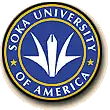 | |
| Motto | Be philosophers of a renaissance of life; |
|---|---|
| Type | Private |
| Established | 2001 |
| Endowment | $1.2 billion (2017)[1] |
| President | Edward M. Feasel[2] |
Academic staff | 67 |
| Students | 442 (Fall 2018)[3] |
| Undergraduates | 428 (Fall 2018) |
| Postgraduates | 14 (Fall 2018) |
| Location | , , United States 33°33′18″N 117°44′06″W |
| Campus | Suburban; 103 acres (42 ha)[4] |
| Colors | Blue, white, and gold |
Sporting affiliations | NAIA |
| Mascot | Lions |
| Website | soka |
A much larger and older sister school, Sōka University in Japan, is located in Hachiōji, Tokyo. SUA encompasses both a four-year liberal arts college and a graduate school offering a Master's program in Educational Leadership and Societal Change.[8] SUA also hosts the Pacific Basin Research Center and the newly created SUA Center for Race, Ethnicity, and Human Rights.
The university has an endowment of $1.2 billion as of 2017,[1] giving it the second-highest endowment per student of any college or university in the United States.[9]
History and philosophy
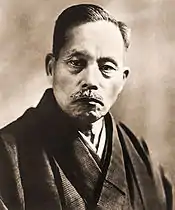
SUA is a secular and nonsectarian university founded by Daisaku Ikeda, the President of Soka Gakkai International (SGI). SUA's philosophical foundation originated in the work of Tsunesaburō Makiguchi, who was the first President of Soka Gakkai (previous name Soka Kyoiku Gakkai) and created a society for educators dedicated to social and educational reform in Japan during the years leading up to World War II.[7]:6 Makiguchi was an elementary school principal, strongly influenced by John Dewey and American educational progressivism.
Between 1930-1934, Makiguchi published his four-volume work, Sōka Kyōikugaku Taikei (Value Creating Education System), to argue for his belief that education should proceed through dialogue instead of "force-feeding" information to students. This student-centered and humanistic philosophy, he argued, made "the purpose of education" an effort "to lead students to happiness." Education, he asserted, should be directed toward "creating value" for the individual and society. Makiguchi was a pacifist and an ardent believer in religious liberty and freedom of conscience. Jailed by Japanese authorities during World War II for ideas and actions inimical to the war effort, he died in prison on 18 November 1944. After the war, as the Soka Gakkai organization grew, Makiguchi's educational philosophy became the centerpiece of a number of Soka schools in Japan advocated by his successors, Jōsei Toda (second President of Soka Gakkai, a former elementary school teacher) and Daisaku Ikeda (third President of Soka Gakkai), who is the founder of SUA. Ikeda describes the founding of SUA as the fruition of the dreams of Makiguchi and Toda.[10][11]
Campus
Calabasas
In 1987, SUA was formed as a not-for-profit organization incorporated in the state of California. Initially it was a small graduate school located on the 588-acre (2.38 km2) former Gillette−Brown Ranch in Calabasas and the Santa Monica Mountains.[12] Originally the location was the site of pre-Columbian Talepop, a settlement of the Chumash people.[13] It was within the Spanish land grant Rancho Las Virgenes in the 19th century.[12] In the 1920s, it became the rural estate of King Gillette with a mansion designed by Wallace Neff. In 1952, it became the Claretville seminary of the Claretian Order of the Catholic Church, and in 1977 it became the religious center of Elizabeth Clare Prophet and the Church Universal and Triumphant (CUT).[12] In 1986, CUT sold the 219 acres (89 ha) property to Soka University of Japan.[12]
Soka University of America(SUA), originally called Soka University of Los Angeles (SULA), initially operated a small ESL (English as a Second Language) school at the Calabasas campus, enrolling just under 100 students. In 1990, SUA announced plans to build a future liberal arts college on campus[14] and plans to expand the facility over the next 25 years to an enrollment of as many as 5,000 students.[12] SUA began making plans to expand the campus infrastructure to accommodate living quarters and classrooms for the proposed expansion, but ran into opposition from some local residents, the Santa Monica Mountains Conservancy, environmentalists, and government representatives.[12] Opponents sought to protect the Chumash ancestral site, the natural habitats and ecology, and the expansive open space viewshed within the Santa Monica Mountains National Recreation Area, and to prevent a development of unprecedented urban density adjacent to Malibu Creek State Park.[15][16]
In 1992, the Mountains Recreation and Conservation Authority (MRCA), a joint-powers authority associated with the Santa Monica Mountains Conservancy, resorted to its powers of eminent domain to condemn the core parcel comprising the university and thereby halted SUA’s plans for expansion.[12] SUA appealed the eminent domain action. In 1994, SUA opened a small graduate school, offering an MA in Second and Foreign Language Education with a concentration in Teaching English to Speakers of Other Languages (TESOL.) The legal debate continued for the remainder of the decade. Soka University was prevented from developing any expansion plans at the Calabasas property and began looking for alternative sites to build a larger campus.
The Graduate School held its first commencement in December 1995, and in the same year SUA acquired a 103-acre site in Aliso Viejo for a private non-profit four-year liberal arts college. The Aliso Viejo campus opened on May 3, 2001 to a freshman class of 120 students from 18 countries and 18 states. In June 2005, Soka University received its accreditation from the Accrediting Commission for Senior Colleges and Universities of the Western Association of Schools and Colleges (WASC.)[17]
SUA sold the Calabasas property in April 2005[18] to a coalition of buyers led by the Mountains Recreation and Conservation Authority (MRCA).[12][19] The former campus is now public parkland, known as King Gillette Ranch Park, and houses the visitor center for the Santa Monica Mountains National Recreation Area.[19] In 2007, the Calabasas campus was closed and the Graduate School relocated to the Aliso Viejo campus.[20]
Aliso Viejo
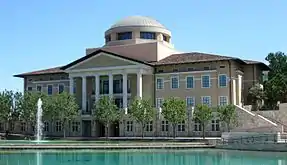
In 1995, the university bought 103 acres (0.42 km2) of rough-graded property for $25 million in Aliso Viejo, located in southern Orange County, California. It then spent $225 million to build the first 18 buildings of the new campus, which opened to 120 first year undergraduate students on 24 August 2001. The architecture was designed in a style resembling an Italian hillside village in Tuscany, with red-tiled roofs, stonework, and earth colors.[21] Three academic buildings were named after the founder and Sōka Gakkai's third president Daisaku Ikeda and his wife, Kaneko Ikeda; 20th−century peace activists Linus Pauling and Eva Helen Pauling; and Mohandas Gandhi and Kasturba Gandhi. An additional academic building dedicated in 2012 was named after Nobel Peace Laureate Wangari Maathai.[22]
Since August 2007 the Aliso Viejo campus has been the home for all of SUA's graduate, undergraduate, and research programs. The Aliso Viejo campus is bordered on three sides by Aliso and Wood Canyons Wilderness Park encompassing a 4,000-acre (16 km2) county wildlife sanctuary.
Academics
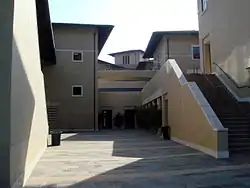
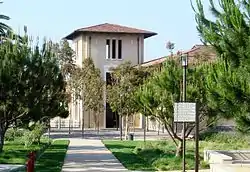
SUA has an 8:1 student/faculty ratio and an average class size of 12.
- The undergraduate college offers a Bachelor of Liberal Arts with emphasis areas in Environmental Studies, Humanities, Social & Behavioral Sciences, International Studies, or Life Sciences. Classrooms typically use seminar methods.[7]:6
- The graduate school offers a Master of Arts degree in Educational Leadership and Societal Change.[23]
- The Pacific Basin Research Center supports research on the humane and peaceful development of the Asia-Pacific Region, including the Latin American border states. It awards grants and fellowships to researchers studying public policy interactions in the Pacific Rim in such areas as international security, economic and social development, educational and cultural reform, environmental protection and human rights. The Center also sponsors campus conferences, occasional lecture series, and student seminars that extend and support its research activities.[24]
- The Center for Race, Ethnicity, and Human Rights will host individuals from around the country and the globe who work to increase understanding and progress on addressing the issues confronting society, including global and local ethnic conflict as well as systemic and institutional racism in the United States.
Rankings
| University rankings | |
|---|---|
| Liberal arts colleges | |
| U.S. News & World Report[25] | 27 |
| Washington Monthly[26] | 87 |
Soka University of America's ranking in the U.S. News & World Report 's 2020 edition of Best Colleges is tied for 27th overall, 7th in "Best Value", and 9th in "Top Performers on Social Mobility" among U.S. liberal arts colleges.[27]
For 2020, Washington Monthly ranked Soka 87th among liberal arts colleges in the U.S. based on their contribution to the public good, as measured by social mobility, research, and promoting public service.[28]
In 2015, the Christian Science Monitor listed SUA 2nd on a top 10 list of the most globally minded colleges.[29]
Curriculum
There are no discipline-based departments at Soka University. Instead the university has focused on interdisciplinarity, a movement in collegiate curriculum that is used by certain American colleges and universities, including the nearby University of California, Irvine.[30]
SUA undergraduates get a bachelor's degree in Liberal Arts, while choosing one of five possible concentration tracks:[7]:48
- Environmental Studies
- Humanities
- International Studies
- Life Sciences
- Social & Behavioral Sciences
Learning clusters
Learning clusters are three-week intensive courses focused on a significant problem of contemporary relevance. Faculty and students develop learning clusters in collaboration during each fall semester. The primary goal is to produce an "educated response" and build student skills for research, critical thought, and active engagement in the world. Learning clusters typically create a collaborative final project designed to be shared with the "off campus" world in some way.[7]:68 Each year several learning clusters travel within and outside the United States (South America, Central America, China, India, and Korea as well as other places) with funding from the Luis & Linda Nieves Family Foundation.
Study abroad
All undergraduate students at Soka University of America must study a non-native language. The languages offered are Spanish, French, Mandarin Chinese, and Japanese. The language must be studied for two years, then all undergraduate students at Soka University of America study abroad for one semester in the spring or fall of their junior year in a country whose language they are studying (costs included in tuition).[31] SUA was the first liberal arts college in the US to require mandatory study abroad for all students when it opened in 2001.[32] The first students went abroad in 2004.
Student life
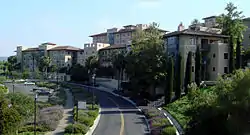
About 60% of SUA's student body is from the United States, with the other 40% coming from 30 other countries on six continents. From 2014 until the present, Soka University has been ranked #1 in "Foreign Student Factor" (highest percentage of international students) among national liberal arts colleges by U.S. News & World Report.[33]
SUA is a residential college and students live on campus in one of eight residential buildings. Parking is free on campus and a free half-hourly shuttle service is offered to enrolled students.
Athletics
Soka University teams, nicknamed the Lions, are part of the National Association of Intercollegiate Athletics (NAIA), primarily competing in the California Pacific Conference (CalPac). Sports for both men and women include cross country, soccer, swimming, track & field and women's golf.[34]
Admissions and graduation rate
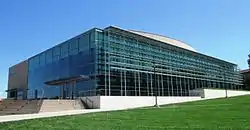
For the Class of 2022 (enrolling fall 2018), Soka received 462 applications, accepted 180 (39.0%) and enrolled 111.[35] The middle 50% range of SAT scores was 570–670 for reading and 610–740 for math, while the middle 50% range for the ACT composite score was 25–30 for enrolled first year students.[35]
Since 2008, full tuition Soka Opportunity Scholarships are available for admitted students whose families make $60,000 or less.[36] SUA was named #4 in U.S. News and World Report's 2015 national rankings for "Best Value - Liberal Arts Colleges".[37]
Between 2005-2007 SUA graduated its first three undergraduate classes with an average graduation rate of 90%. As of 2007, 38% of SUA graduates had gone on to graduate programs.[38]
Expansion
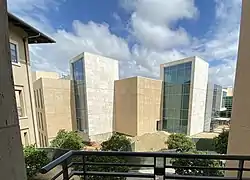
In 2017, Soka University of America began construction on two new residential halls and a new science building. Each new residence hall houses 50 people, allowing the campus to expand its student population by 100. The science hall is the home of the new Life Sciences Concentration, which allows undergraduates to complete pre-med requirements and study topics related to biology, medicine, and health. Both projects were completed by Fall 2020.[39][40]
Ultimately, Soka University of America plans to build additional residence halls, academic buildings and expanded dining facilities to accommodate up to a maximum of ~1,000 students in total.[41]
Notable people
A notable alumna of Soka University of America is Tahereh Mafi, New York Times best selling author.[42] Notable faculty includes humanities professors Robert Allinson and Jim Merod, the latter having recorded numerous jazz artists (including Herbie Hancock and Ella Fitzgerald) in addition to his scholarship.[43][44]
Allegations of sectarianism
In 2003, two professors claimed they experienced religious discrimination, breach of contract as well as age discrimination. One professor took legal action against SUA based on these allegations, but her case was dismissed on summary judgment.[45] University administrators disputed all allegations of discrimination and noted that the majority of faculty and staff are not Buddhist, said there was no evidence of preferential treatment, and said that Soka University has never taught nor will it teach Buddhist—or any other—religious practices.[46][47][48]
In 2011, Michelle Woo wrote an article for OC Weekly, a local publication in Orange County, California, in which she mentioned possible proselytizing of non-Buddhist staff and students.[49] The article was disputed by Soka University students, faculty, and staff.[50]
See also
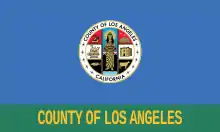 Greater Los Angeles portal
Greater Los Angeles portal
References
- "The Integrated Postsecondary Education Data System". nces.ed.gov. Retrieved 5 August 2020.
- "Edward M. Feasel Named President of Soka University of America". www.soka.edu (Press release). July 17, 2020. Retrieved 25 November 2020.
- "Soka University of America Common Data Set 2018-2019, Part B". Soka University of America.
- "Fast Facts". Soka University of America. Retrieved September 22, 2019.
- "Soka University of America". National Center for Charitable Statistics. Archived from the original on 2014-08-14. Retrieved 2014-08-04.
- Gingold, Naomi. "A Buddhist-founded university is now firmly in the mainstream". The World from PRX. Retrieved 5 August 2020.
- Undergraduate Catalog 2013-2014 (PDF). Soka University.
- http://www.soka.edu/academics/academics-overview-ma-program/default.aspx
- "Rankings | Largest college endowment per student - Highest endowment per student". www.collegeraptor.com. Retrieved 5 August 2020.
- Sharma, 1999
- Bethel, 1990
- "SMMC.ca.gov: "Preliminary Determination of Eligibility Gillette-Brown Ranch, California"" (PDF).
- "The Historical Ecology of Talepop, an Interior Chumash Settlement in the Santa Monica Mountains | Society of Ethnobiology". ethnobiology.org.
- "Soka University Expansion Stirs Calabasas Controversy," Los Angeles Times, Sept. 24, 1990, http://articles.latimes.com/1990-09-24/local/me-913_1_soka-university-map/2
- Aaron Curtiss (12 December 1993). "Soka University: Fight Brews Over Land in the Santa Monicas". The Los Angeles Times. Retrieved 5 December 2013.
- Loesing, John (13 March 2003). "Environmentalists beat Soka University—again". The Acorn. Archived from the original on 27 December 2013. Retrieved 5 December 2013.
- University Catalog 2014-2016, Soka University of America, pg. 5
- "Santa Monica Mountains Conservancy". smmc.ca.gov.
- "Soka University campus sold to Conservation Authority". Los Angeles Business. April 22, 2005. Archived from the original on 2005-12-27. The former campus is now managed jointly by the Mountain Recreation and Conservation Authority, the state parks department, and the Santa Monica Mountains National Recreation Area.
- University Catalog,Soka University of America, pg. 5S
- Roark, Anne C. (Spring 2002). "Soka University". National Cross Talk. National Center for Public Policy and Higher Education. Retrieved 2014-08-15.
- http://www.soka.edu/about_soka/our_campus/campus-map.aspx
- "Academics Overview (MA Program)". Soka University. Retrieved 2014-08-15.
- Montgomery, John D (1998). Human Rights: Positive Policies in Asia and the Pacific Rim. Hollis, NH: Hollis Publishing Company. p. x. ISBN 1-884186-09-2.
- "Best Colleges 2021: National Liberal Arts Colleges". U.S. News & World Report. Retrieved September 24, 2020.
- "2020 Liberal Arts Rankings". Washington Monthly. Retrieved August 31, 2020.
- "Soka University of America Rankings". U.S. News & World Report. Retrieved September 22, 2019.
- "2020 Liberal Arts College Rankings". Washington Monthly. Retrieved September 1, 2020.
- "Top 10 most globally minded colleges". Christian Science Monitor. 2015-08-29. ISSN 0882-7729. Retrieved 2018-07-01.
- "Introduction < University of California, Irvine – 2018-19 Catalogue". catalogue.uci.edu. Retrieved 2019-05-02.
- "Soka University of America". US News & World Report. 2014. Archived from the original on 2014-07-17.
- "New West Coast College, Born of the Far East" by Todd S. Purdon, New York Times, July 20, 2001, Pg 1
- "Most International Students". US News & World Report. 2014. Archived from the original on 2014-07-17.
- "Soka University Athletics - Official Athletics Website". Soka University Athletics.
- "Common Data Set 2018–2019, Part C". Soka University of America.
- "Soka University Announces New Tuition Policy" (PDF). Soka University. Archived from the original (PDF) on 2008-10-30.
- "U.S. News & World Report Announces the 2016 Best Colleges". US News & World Report. 2015-09-09. Retrieved 2016-06-02.
- Four-Year Colleges 2008. Peterson's. July 17, 2007. ISBN 978-0768924008.
- "Soka University of America - New Science Hall Construction Begins". www.community.soka.edu. Retrieved 2018-04-08.
- "Aliso Viejo council OKs Soka University's expansion plans". Orange County Register. 2017-08-22. Retrieved 2018-04-08.
- "Frequently Asked Questions -". www.soka.edu. Retrieved 2018-04-08.
- "Soka University of America - Profile, Rankings, and Data".
- www.soka.edu http://www.soka.edu/about_soka/staff/Faculty-Full-Time/Jim-Merod.aspx. Retrieved 2018-07-01. Missing or empty
|title=(help) - "About - BluePort Jazz". www.blueportjazz.net. Retrieved 2018-07-01.
- Woo, Michelle (April 18, 2011). "Former Soka University Professor Loses Appeal in Religious Discrimination Case". OC Weekly. Archived from the original on November 14, 2015. Retrieved October 21, 2015.
- "Soka University under fire". Religion Report. ABC. 21 May 2003. Archived from the original on 2014-08-12.
- Snyder, Martin D. (Mar–Apr 2003). "State of the Profession:Sailing under False Colors". Academe. 89 (2): 111. doi:10.2307/40252413. JSTOR 40252413.
- Habuki, Daniel (Sep–Oct 2003). "New University Slighted". Academe. 89 (5): 6–7. doi:10.2307/40253380. JSTOR 40253380.
- Woo, Michelle (March 10, 2011). "Soka University of America Is a School On a Hill". OC Weekly. Archived from the original on November 6, 2014. Retrieved 2014-08-13.
- Kissell, Ted (March 14, 2011). "About That Soka University Cover: A Note From the Editor". OC Weekly. Archived from the original on March 21, 2015. Retrieved 2015-04-02.
Bibliography
- Bethel, Dayle M. ed. (1990). Education for Creative Living: Ideas and Proposals of Tsunesaburo Makiguchi. Ames, Iowa: Iowa State University Press.
- Sharma, Namrata (1999). Value Creators in Education: Japanese Educator Makiguchi & Mahatma Gandhi and their relevance for the Indian education. New Delhi: Regency Publications.